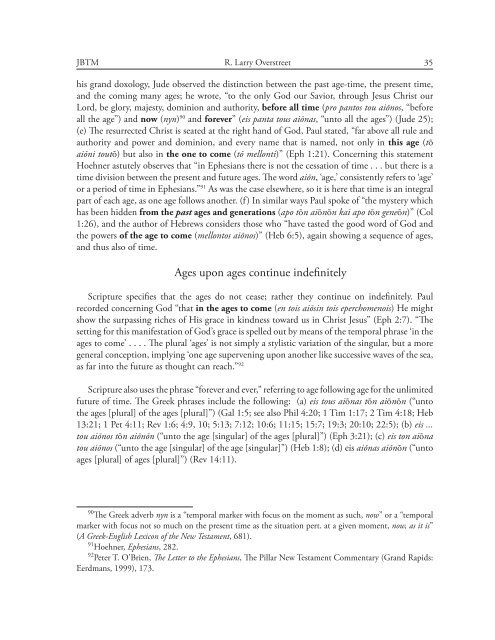JBTM_10-2_Fall_2013
JBTM_10-2_Fall_2013
JBTM_10-2_Fall_2013
Create successful ePaper yourself
Turn your PDF publications into a flip-book with our unique Google optimized e-Paper software.
<strong>JBTM</strong><br />
R. Larry Overstreet<br />
35<br />
his grand doxology, Jude observed the distinction between the past age-time, the present time,<br />
and the coming many ages; he wrote, “to the only God our Savior, through Jesus Christ our<br />
Lord, be glory, majesty, dominion and authority, before all time (pro pantos tou aiōnos, “before<br />
all the age”) and now (nyn) 90 and forever” (eis panta tous aiōnas, “unto all the ages”) (Jude 25);<br />
(e) The resurrected Christ is seated at the right hand of God, Paul stated, “far above all rule and<br />
authority and power and dominion, and every name that is named, not only in this age (tō<br />
aiōni toutō) but also in the one to come (tō mellonti)” (Eph 1:21). Concerning this statement<br />
Hoehner astutely observes that “in Ephesians there is not the cessation of time . . . but there is a<br />
time division between the present and future ages. The word aiōn, ‘age,’ consistently refers to ‘age’<br />
or a period of time in Ephesians.” 91 As was the case elsewhere, so it is here that time is an integral<br />
part of each age, as one age follows another. (f) In similar ways Paul spoke of “the mystery which<br />
has been hidden from the past ages and generations (apo tōn aiōnōn kai apo tōn geneōn)” (Col<br />
1:26), and the author of Hebrews considers those who “have tasted the good word of God and<br />
the powers of the age to come (mellontos aiōnos)” (Heb 6:5), again showing a sequence of ages,<br />
and thus also of time.<br />
Ages upon ages continue indefinitely<br />
Scripture specifies that the ages do not cease; rather they continue on indefinitely. Paul<br />
recorded concerning God “that in the ages to come (en tois aiōsin tois eperchomenois) He might<br />
show the surpassing riches of His grace in kindness toward us in Christ Jesus” (Eph 2:7). “The<br />
setting for this manifestation of God’s grace is spelled out by means of the temporal phrase ‘in the<br />
ages to come’ . . . . The plural ‘ages’ is not simply a stylistic variation of the singular, but a more<br />
general conception, implying ‘one age supervening upon another like successive waves of the sea,<br />
as far into the future as thought can reach.” 92<br />
Scripture also uses the phrase “forever and ever,” referring to age following age for the unlimited<br />
future of time. The Greek phrases include the following: (a) eis tous aiōnas tōn aiōnōn (“unto<br />
the ages [plural] of the ages [plural]”) (Gal 1:5; see also Phil 4:20; 1 Tim 1:17; 2 Tim 4:18; Heb<br />
13:21; 1 Pet 4:11; Rev 1:6; 4:9, <strong>10</strong>; 5:13; 7:12; <strong>10</strong>:6; 11:15; 15:7; 19:3; 20:<strong>10</strong>; 22:5); (b) eis ...<br />
tou aiōnos tōn aiōnōn (“unto the age [singular] of the ages [plural]”) (Eph 3:21); (c) eis ton aiōna<br />
tou aiōnos (“unto the age [singular] of the age [singular]”) (Heb 1:8); (d) eis aiōnas aiōnōn (“unto<br />
ages [plural] of ages [plural]”) (Rev 14:11).<br />
90 The Greek adverb nyn is a “temporal marker with focus on the moment as such, now” or a “temporal<br />
marker with focus not so much on the present time as the situation pert. at a given moment, now, as it is”<br />
(A Greek-English Lexicon of the New Testament, 681).<br />
91 Hoehner, Ephesians, 282.<br />
92 Peter T. O’Brien, The Letter to the Ephesians, The Pillar New Testament Commentary (Grand Rapids:<br />
Eerdmans, 1999), 173.


